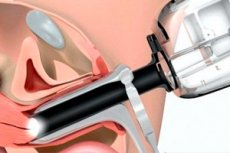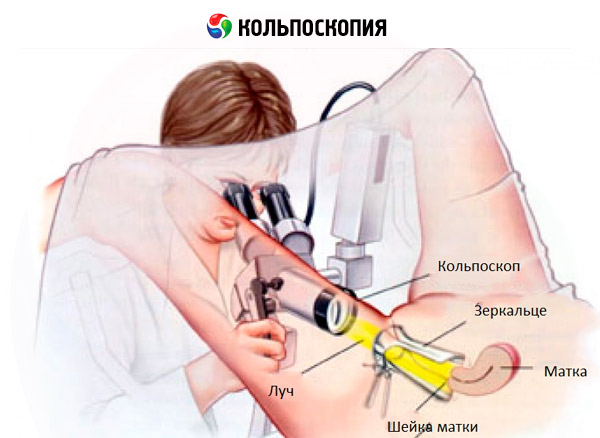Medical expert of the article
New publications
Colposcopy
Last reviewed: 07.07.2025

All iLive content is medically reviewed or fact checked to ensure as much factual accuracy as possible.
We have strict sourcing guidelines and only link to reputable media sites, academic research institutions and, whenever possible, medically peer reviewed studies. Note that the numbers in parentheses ([1], [2], etc.) are clickable links to these studies.
If you feel that any of our content is inaccurate, out-of-date, or otherwise questionable, please select it and press Ctrl + Enter.

Colposcopy was proposed in 1925 by Hinzelman. Colposcopy allows for a detailed examination of the vaginal portion of the cervix and vaginal walls using a special optical device - a colposcope. The colposcope design includes an optical lens system with a focal length of 25-28 cm and replaceable eyepieces that provide magnification from 6 to 28 times. Modern colposcopes have a photo attachment that allows for documenting the examination data.
Some colposcope models allow for research using fluorescence analysis - the detection of secondary luminescence in ultraviolet rays.
Indications for the procedure
Conducting diagnostics and differential diagnostics of pathological changes in the vaginal part of the cervix, vaginal walls and vulva.
In gynecological practice, the following types of colposcopic examination are performed sequentially.
Types of colposcopy
Simple colposcopy is an examination of the cervix that is of an indicative nature. The shape, size of the cervix and external os, color, relief of the mucous membrane, the border of the squamous epithelium covering the cervix and the cylindrical epithelium of the cervical canal are determined.
Extended colposcopy - examination after treatment of the cervix with a 3% solution of acetic acid, which causes short-term edema of the epithelium, swelling of the cells of the styloid layer, contraction of the subepithelial vessels and reduction of blood supply. The effect of acetic acid lasts for 4 minutes.
After examining the colposcopic picture of the cervix treated with acetic acid, the so-called Schiller test is performed - the cervix is lubricated with a cotton swab soaked in 3% Lugol's solution. The iodine contained in the solution stains the glycogen in the cells of healthy, unchanged squamous epithelium of the cervix dark brown. Thinned cells (atrophic age-related changes), as well as pathologically altered cells in epithelial dysplasias, are poor in glycogen and are not stained with iodine solution. In this way, zones of pathologically altered epithelium are identified and areas for biopsy are marked.

Colpomicroscopy. Intravital histological examination of the vaginal portion of the cervix. It is performed with a contrast fluorescent colpomicroscope, the tube of which is brought directly to the cervix; magnification up to 300 times. Before examination, the cervix is stained with 0.1% hematoxylin solution. During colpomicroscopy of an unchanged cervix, the cells of the squamous epithelium covering it have a polygonal shape, with clear boundaries, the cell nuclei are stained purple, the cytoplasm is blue; the subepithelial vessels, visible at a depth of 70 μm, have a rectilinear direction and uniform division, their bed is not expanded. The colpomicroscopic method of examination has a high accuracy in detecting pathological changes, the coincidence of this method with the results of a histological examination of the cervix is 97.5%.
Chromocolposcopy is a modification of extended colposcopy, in which the cervix is stained with various dyes (methyl violet, 0.1% hematoxylin solution, 1% toluidine blue solution). The difference in the color of flat and columnar epithelium allows for the clarification of the pathological process and its external boundaries.
A type of extended colposcopy is the examination of the colposcopic picture of the vaginal mucosa of the cervix through green and yellow filters, as well as examination under ultraviolet rays to identify clearer contours of blood vessels.
Fluorescent colposcopy is an examination of the cervix in ultraviolet rays after staining it with a fluorochrome (an intravital method of histochemical examination of tissues using ultraviolet rays). Uranine is used as a fluorochrome in a dilution of 1:30,000. Normal mucous membrane is characterized by a dark blue and violet glow. In early forms of cancer, a bright yellow, light green, crimson glow is noted. In severe cancer with necrosis and hemorrhages, complete quenching of fluorescence is observed. Coincidence of diagnoses in fluorescent colposcopy with histological data is noted in 98% of cases.
Colpomicroscopy is the most advanced method of examining the vaginal portion of the cervix, allowing it to be examined with a magnification of 175-280 times. This is a lifelong histological study of cervical tissue in incident light. When studying the epithelial cover and the characteristics of cellular structures, the cervix is stained with a 0.1% aqueous solution of hematoxylin. Usually, targeted colpomicroscopy is used, which is based on staining suspicious areas identified during colposcopy.
The advantage of colpomicroscopy is that it is a completely harmless and painless method that allows studying morphological changes in the surface of the cervix in dynamics both in normal conditions and in pathology. This method is highly reliable.
The disadvantage of the method is that it allows one to judge only the condition of the superficial layers of the epithelium and does not provide the possibility of identifying and differentially diagnosing intraepithelial carcinoma and invasive cancer. The method is not informative enough in case of damage to the cervical canal. It cannot be used in case of vaginal narrowing, tissue bleeding, or necrotic changes in the cervix.
Fluorescent colpomicroscopy is an improved method of colposcopy that complements examination data and expands the possibilities of topical diagnostics.
Decoding the results
The colposcopic method of examining the cervix is highly accurate in identifying precancerous and cancerous diseases of the cervix, in diagnosing cervical endometriosis, polyps, and endocervicitis.
During colposcopy, normal epithelium appears smooth, shiny, light pink in color, and after treatment with Lugol's solution, the cervix acquires a uniform brown color.
Benign colposcopic changes include ectopia, transformation zone, true erosion, changes associated with colpitis and previously undergone diathermocoagulation.
Atypical colposcopic features include leukoplakia, leukoplakia base, papillary base, margins, typical transformation zone, and atypical vessels.
Ectopia is characterized by the formation of papillae with loop-shaped vessels in them. The transformation zone is a section of the cervix where the prismatic epithelium is replaced by a multilayered flat epithelium. These are smooth areas near the ectopia papillae, against the background of which the gland openings are located. True erosion is a section of the vaginal part of the cervix that is devoid of epithelial cover. In colpitis, many small blood vessels are visible on the walls of the cervix and vagina.
Leukoplakia is a shiny white spot, sharply demarcated from the surrounding mucous membrane, iodine-negative when treated with Lugol's solution.
The base of leukoplakia is red grains on a white or yellowish background, iodine negative. The fields are white or yellowish polygonal areas separated by thin red borders, iodine negative.
Atypical transformation zone is various combinations of atypical epithelium, also iodine negative. Atypical vessels are randomly located, have a bizarre shape, there are no anastomoses between them. During Schiller's test they do not disappear, as with benign changes, but become more clearly visible.
Precancerous conditions are characterized by the presence of atypical epithelium located at different widths, severe keratinization and an atypical state of the mucous membrane.
In preinvasive cancer, atypism of blood vessels is observed; in microcarcinoma, there is a chaotic arrangement of blood vessels and heterogeneity of relief.
What do need to examine?


 [
[